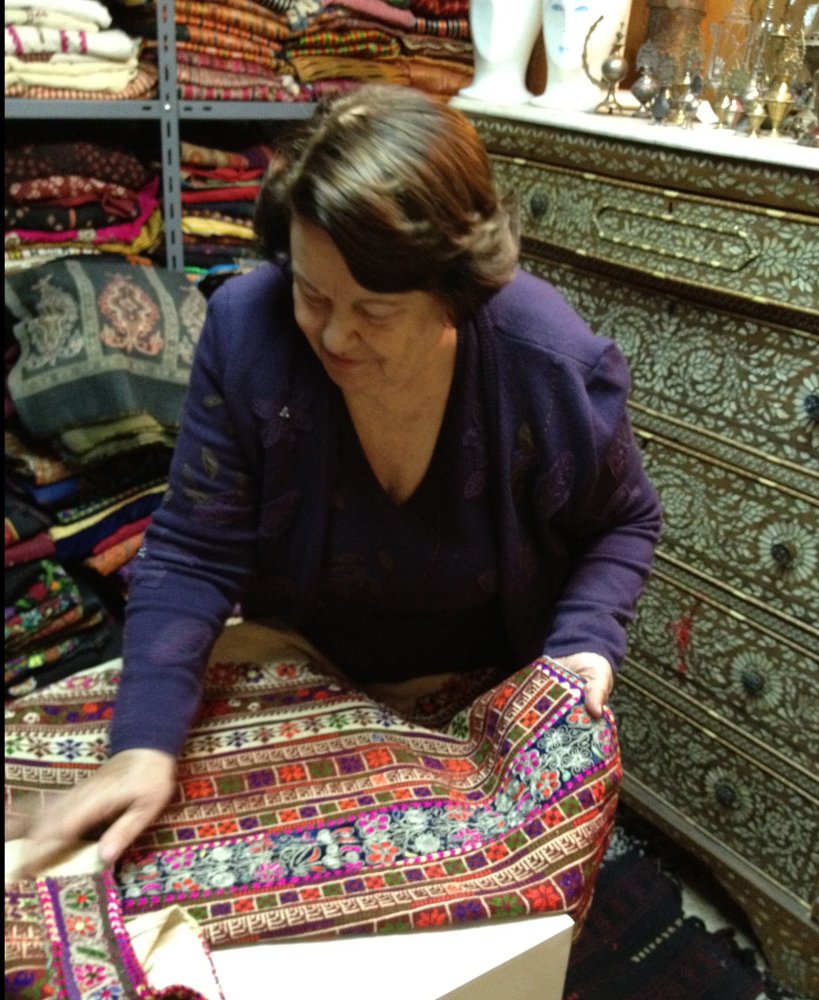On my last trip to Jordan, I was fortunate to view an extraordinary collection in a private home in Amman that documented a Palestine that many never knew.
Travel to Jordan is always magnificent. It is a traveler’s paradise of a warm and welcoming people, history, natural history and the best food in the world. Petra, Jerash, the Dead Sea and Mount Nebo all have mesmerized visitors for centuries. Still, there are always more wonders.
In a lovely home in suburban Amman, I met Widad Kamel Kawar, who has dedicated her life to collecting, documenting and researching Arab costumes, most specifically, Palestinian embroidery. Her home houses the largest collection of Arab traditional dress and accessories in the world.

Entering Mrs. Kawar’s beautiful, hospitable home, you would never guess that the lower floors housed a collection that preserves the heritage and culture of generations of Palestinian women. Over 3000 textiles covering Palestinian, Jordanian and other Arab traditional dress are carefully folded, hung and stored away from sunlight. Following the obligatory coffee and wonderful cake, we got down to business quickly. She had a lot to teach me and I was a willing student.
I was told to sit at a high table and Widad began to systematically unfurl thobs (the traditional richly embroidered costume of Palestinian women). Each pattern of embroidery, color and weave of the fabric had a story about the region, lifestyle and lives of the women who wore them.
Bedouin wedding, village life or mourning wear all showed the rich cultural diversity of the pre-1948 Palestinian population. The extraordinary craftmanship can be seen in the close up photos below. Widad told me the personal stories of some of the women who wore these costumes. She insisted I try on many of the gorgeous outfits, completely accessorized with the appropriate jewelry and accessories as you can see below.
Through her stories of others, I also learned her story. She was born near Nablus on the West Bank. In 1941 her family moved to Bethlehem. In her book, Threads of Identity, she notes that
“Bethlehem was… the fashion and weaving centre for many villages… the Paris of central Palestine.” Here she met those creating the finest clothing and jewelry in Palestine and learned to appreciate the skills of these dynamic women. A passion was ignited. Following 1948, her collecting took on a different urgency and became a way to preserve and document the culture and heritage she had known and admired, before the creation of Israel displaced the Palestinian population.
As with all collections, preserving a past heritage is important. For Palestinians, preserving these textiles with their rich, descriptive embroidery, takes on added significance. Can a culture be preserved and reconstructed through its costumes?
After my four hours with this collection, I believe it can.

I have visited the West Bank, driven past the refugee camps in Jordan and know the history of the Palestinian diaspora, but through this collection, I could glimpse, touch and sense the richness of their culture and past that is lost on westerners hearing daily news reports. Mrs. Kawar’s preservation efforts for the beautiful clothing created and worn by Palestinian women is one of the most significant museum collections I have encountered in my travels. I hope it can be shared with a much wider audience in the future.
An interesting side note. A designer from the House of Hermes visited her in 2011 to find inspiration from her collection for their own designs.
Threads of Identity is the title of Mrs. Kawar’s wonderful book documenting her collection. I highly recommend it.
